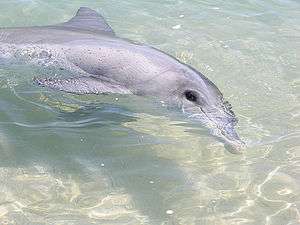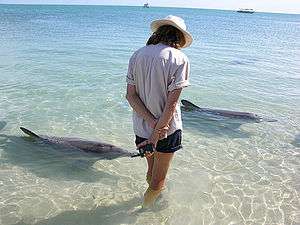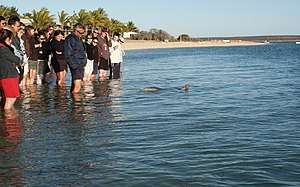Monkey Mia
Monkey Mia is a popular tourist destination located about 900 km north of Perth, Western Australia.[1] The reserve is 25 km northeast of the town of Denham in the Shark Bay Marine Park and World Heritage Site.



The main attraction are the bottlenose dolphins that have been coming close to shore for more than fifty years. Rangers from the Department of Parks and Wildlife (Western Australia) carefully supervise the interaction between humans and dolphins.
History
Mia is the Aboriginal term for home or shelter, while the Monkey part of the name is allegedly derived from a pearling boat called Monkey that anchored at the now Monkey Mia in the late 19th century, during the days when pearling was an industry in the region. However, the Geographic Names Committee, hosted by Landgate (the Western Australian Land Information Authority) has stated that the most likely origins of the name are that it was included in a list of Aboriginal names and their meanings supplied by the Geraldton Police Station in approx 1899 (the meaning of the name is given as "Salt or bad water") or after the pet monkeys owned by early Malay pearlers who camped at the location, or as a colloquialism for "sheep",[2] or that it was named for a schooner called Monkey that arrived in 1834.
The area was originally gazetted in 1890 and used as a base for the pearling and fishing industries. In the 1960s, a fisherman and his wife began feeding bottlenose dolphins when returning with their catch. As news of the dolphins coming inshore spread, visitors started to come to see them.[3] In 1985, an information centre was built, and in 1988, a special state government grant was provided to develop roads, carparks, and facilities.
In November 1990, the waters adjoining Monkey Mia were declared a marine park and are managed by the Department of Parks and Wildlife.
In recent years, more attention has been given to the Aboriginal roots of the area and their knowledge of the local land. For visitors, the most visible evidence of this change is the culture walks, where visitors are taught to respect the land.[4]
These days, a small pod of dolphins from a larger super-pod regularly swim to shore up to three times a day, and on average seven or eight dolphins regularly visit, with up to 20 others visiting less frequently; it can take several years before they gain the confidence. Park rangers closely supervise the interaction and hand out fish to selected visitors, often children, to hand-feed to the dolphins, although visitors are urged not to touch the dolphins.[5] Due to strict management only five adults are fed, with no more than 10% of their daily dietary intake.[6]
Research
Monkey Mia is also the laboratory location for extensive behavioural and biological research on bottlenose dolphins. Drawn to the area's famous "beach dolphins", researchers Richard Connor and Rachel Smolker started the Monkey Mia dolphin research project in 1982. Their research interests quickly expanded to include hundreds of the nearby Shark Bay dolphins. Since this visit, scientists have come from prestigious institutions in Australia, North America and Europe. The dolphins have been extensively studied by this international team of scientists since 1984.[7][8]
See also
References
- Edwards, Hugh (1989), The remarkable dolphins of Monkey Mia, H. Edwards, ISBN 978-0-7316-7982-9
- Farnsworth, Clyde (14 October 1997). "Monkey Mia Journal; Like to Meet a Wild Dolphin? This Is the Place". The New York Times. Retrieved 5 February 2008.
- Preston, Diana (21 March 2004). "Flippers for Breakfast". The Daily Telegraph. Retrieved 5 February 2008.
- Carter, Terry; Lara Dunston (5 March 2007). "Walk Softly into Aboriginal Culture". The Houston Chronicle. Retrieved 5 February 2008.
- "Meet the Monkey Mia Dolphins".
- "Shark Bay Organisation".
- Western Australia. Environmental Protection Authority; Monkey Mia Dolphin Resort Pty Ltd (2005), Expansion of Monkey Mia Dolphin Resort : Monkey Mia Dolphin Resort Pty Ltd : report and recommendations of the Environmental Protection Authority, Environmental Protection Authority, ISBN 978-0-7307-6804-3
- Western Australia. Department of Conservation and Land Management; Shark Bay (W.A. : Shire). Council; Western Australia. Dept. of Conservation and Land Management; Shark Bay (W.A. : Shire) (1993), Monkey Mia Reserve : draft management plan, The Dept, retrieved 9 August 2019